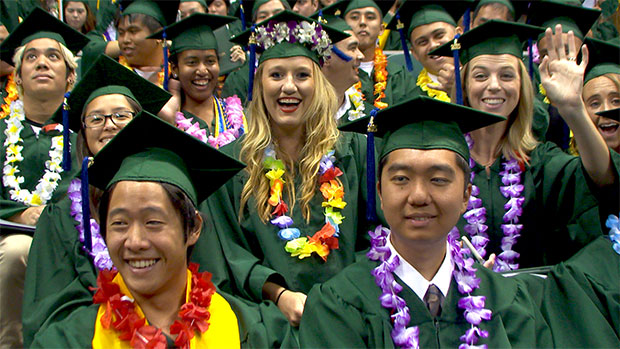The four-year graduation rate at the University of Hawaiʻi at Mānoa reached an all-time high after an 84 percent increase from 2010 to 2016. Thirty-two percent of first-time, full time students who started college in fall 2012 earned a bachelor’s degree in four years, increased from 17.5 percent just 6 years ago.
“For other universities, a one or two percent increase would be considered a big success—an 83-percent increase in seven years is unheard of,” said UH Mānoa Assistant Vice Chancellor Ronald Cambra.
More than 30 undergraduate initiatives undertaken by the university from as far back as 2005 are credited with the significant graduation rate increase.
“This represents a remarkable achievement by the faculty and staff of UH Mānoa who have focused on offering the classes, structures and support services to help students succeed in a timely manner,” said UH President and Interim Mānoa Chancellor David Lassner. “Timely graduation lessens the financial burden on students and their families and helps make higher education more affordable.”

Steps and initiatives
The UH Mānoa Office of Undergraduate Education was established in 2006 and tasked with raising the graduation rate. A team of administrators and faculty from multiple units began by identifying and addressing barriers to student success, such as inconsistent academic policies. The team developed initiatives focused on improving student engagement and the quality of the student experience.
These initiatives included:
- an online degree audit system to engage students on their academic track
- an academic policy of mandatory advising for all students
- creating four-year academic major plans to provide students with a clear path towards degrees
- establishing advising offices in the UH Community Colleges to better assist students transferring to Mānoa
“The central theme of these initiatives was focused on active academic engagement, leading to a working partnership between students and the institution,” said Cambra. “The students develop a sense of stewardship with their school.”
Nationally recognized efforts
Related UH News video: Complete College America
honors UH’s STAR and 15 to Finish programs,
November 11, 2016
One key initiatives is nationally recognized. The STAR program, an online degree audit developed by UH, provides students with a clear pathway to graduation by allowing them to track their progress, review requirements and see how scheduling decisions impact when they can graduate. Administrators also utilize STAR to analyze course pressure points and re-direct resources to meet student demand.
The 15 to Finish campaign, which followed UH Mānoa’s Pathway and “Do It In Four” campaigns, likely played a role as well. This UH-created, nationally recognized campaign encourages students to take 15 credits per semester to ensure on-time graduation. It was launched systemwide in fall 2012, when the 2016 graduating class started at UH as freshmen.
More to be done
Despite the successes, administrators say there is more work to do.
“My real concern now is retention,” said Cambra. “While our four-year rate improves and our number of graduates grows, our retention rates—especially in the first two years—require more attention and a few basic strategies and initiatives.”
Five and six year graduation rates
The Mānoa five year graduation rate also increased, by just over two percent to 53 percent, in fall 2016 and the six year graduation rate is up just over one percent to 58 percent.

